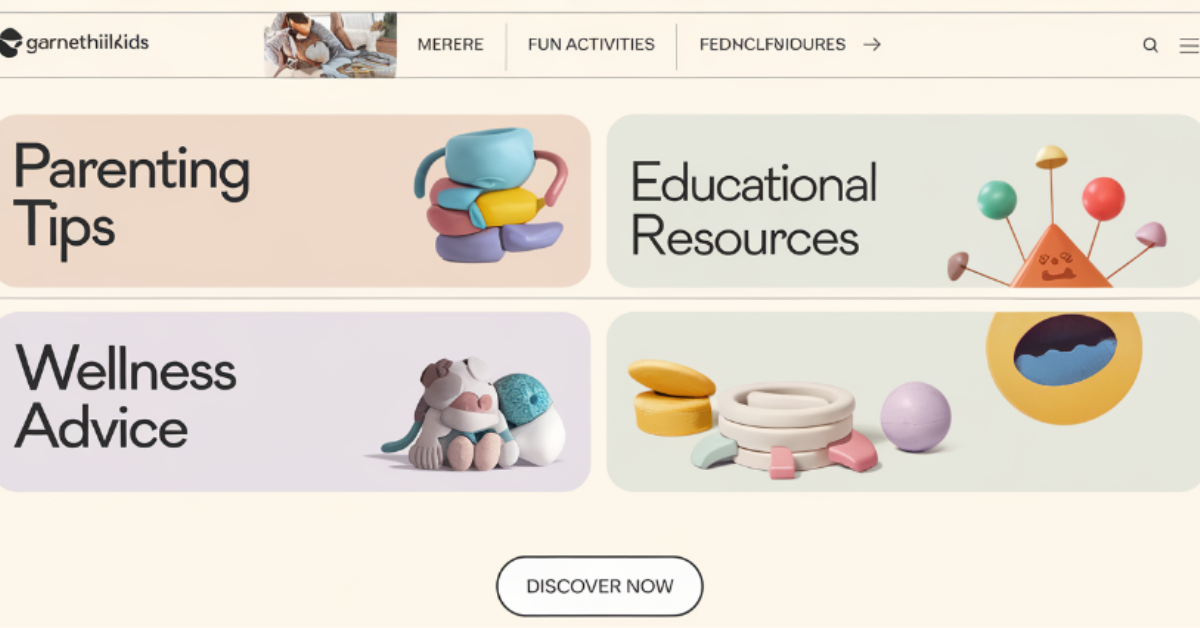EDUCATION
Garnethillskids.com – Parenting Support, Educational Resources, and Fun Activities

Garnethillskids.com – Parenting Support, Educational Resources, and Fun Activities
Parenting is a journey filled with both joys and challenges, and finding trustworthy resources that help nurture a child’s development can be invaluable.
Garnethillskids.com is a dedicated platform that aims to support parents by offering a rich collection of educational resources, engaging activities, health tips, and community-building opportunities.
Whether you’re looking for learning materials, craft ideas, or advice on children’s wellness, Garnethillskids.com is here to help.
This article will explore the unique offerings of Garnethillskids.com, breaking down the features that make it an indispensable tool for modern parenting.
Why Garnethillskids.com Stands Out? One-Stop Hub for Parents!
In an age where countless websites claim to offer educational content, Garnethillskids.com distinguishes itself by focusing on quality, accessibility, and real value for parents and kids alike. This platform brings together expert insights, age-specific learning resources, and a user-friendly experience. Here’s why every parent should consider Garnethillskids.com:
- Comprehensive Resources for Child Development: Covers key areas, including learning, creativity, wellness, and social connection.
- Easily Accessible Content: Designed with busy parents in mind, Garnethillskids.com makes resources easy to navigate and implement.
- Adaptable for Different Age Groups: From toddlers to middle schoolers, this site has something for every stage.
Educational Resources for Every Age Group and Learning Style
Nurturing Knowledge with Fun and Interactive Learning
Garnethillskids.com takes learning beyond traditional methods, focusing on making education engaging and adaptable for kids of all ages. Whether your child is starting preschool or tackling middle school subjects, the site offers a wide range of resources:
- Age-Specific Content: Resources are divided by age, ensuring that materials align with developmental stages.
- Interactive Lessons and Games: These resources are tailored to keep children engaged, using gamified learning to teach everything from basic math to science.
- Homework Assistance and Study Guides: For older kids, Garnethillskids.com provides practical study guides and homework help tips that parents can use to support their child’s academic journey.
- Support for Learning Challenges: The platform offers strategies and modifications for children who may need extra support with their studies.
Fun-Filled Activities and Creative Crafts for All Ages
Unleashing Creativity Through Crafts and DIY Projects
Keeping kids entertained while also stimulating their minds can be challenging, but Garnethillskids.com simplifies the process with a wide variety of activities and crafts:
- Simple DIY Projects: Perfect for younger children, these crafts require minimal materials and are easy to set up. Examples might include creating puppets, decorating jars, or painting stones.
- Advanced Craft Ideas for Older Kids: For kids ready to take on bigger projects, Garnethillskids.com provides detailed craft ideas that require more time and skill, such as creating model castles or making friendship bracelets.
- Benefits Beyond Fun: Craft activities help in building fine motor skills, enhancing creativity, and encouraging independent problem-solving.
Supporting Health and Wellness for Balanced Growth
Fostering a Healthy Lifestyle Through Physical and Mental Wellness Resources
A child’s physical and emotional health is essential to their overall development, and Garnethillskids.com offers extensive support in this area:
- Physical Activity Ideas: Simple exercise routines, family workout suggestions, and fun games encourage kids to stay active.
- Mindfulness and Emotional Wellbeing: Activities like breathing exercises, relaxation techniques, and guided journaling help children learn to manage stress.
- Nutrition Tips and Family Recipes: The platform offers child-friendly, nutritious recipes that encourage kids to eat healthily, helping parents create a balanced diet that suits their child’s tastes and needs.
Read Also: HealthSciencesForum.com
Building a Parenting Community for Shared Experiences
Connecting Parents with Resources, Events, and Each Other
One of Garnethillskids.com’s standout features is its community-building aspect, allowing parents to share their experiences, seek advice, and support each other:
- Parent Forums and Discussion Boards: These spaces enable parents to discuss topics from managing school life to dealing with behavioral challenges.
- Local Events and Family Activities: Garnethillskids.com occasionally lists local family events, making it easier for parents to find outings that are both educational and fun.
- Workshops and Webinars: Experts in education, health, and parenting frequently host online sessions, providing parents with practical knowledge they can apply in their day-to-day lives.
Additional Features that Make Garnethillskids.com Unique
Garnethillskids.com is packed with valuable tools and features that elevate it above other parenting websites. Here are a few unique elements:
- Customizable Learning Plans: Parents can choose specific resources and create a tailored learning path based on their child’s strengths and weaknesses.
- Regularly Updated Content: New activities, articles, and resources keep the platform fresh and relevant.
- User-Friendly Interface: Designed with simplicity in mind, Garnethillskids.com makes it easy for parents to quickly find what they need without unnecessary distractions.
Why Garnethillskids.com is Essential for Every Parent?
Supporting children through each phase of their growth can be daunting, but Garnethillskids.com offers a streamlined approach that takes much of the stress out of parenting:
- An All-Round Resource: From learning to health and creative play, Garnethillskids.com covers every essential aspect of child development.
- Flexible for Busy Schedules: The platform allows parents to access materials as needed, making it easy to find quality resources without spending hours searching.
- Backed by Expert Knowledge: Content is created or reviewed by experts in child development, education, and health, ensuring parents receive reliable, actionable advice.
FAQs:
Q1. What age groups does Garnethillskids.com cater to?
A1. Garnethillskids.com offers resources for children from preschool to middle school, with materials customized for different developmental stages.
Q2. Are the activities and crafts easy for parents to set up?
A2. Yes, the platform provides clear instructions and lists of materials, making it easy for parents to prepare and guide children through each activity.
Q3. How does Garnethillskids.com support children’s mental health?
A3. The site includes resources on mindfulness, emotional well-being, and relaxation exercises that help children manage stress and express their emotions.
Q4. Are the educational resources aligned with school curriculums?
A4. While not identical to specific school curricula, the resources are designed to support and enhance traditional academic subjects.
Q5. Can I use Garnethillskids.com for children with learning difficulties?
A5. Yes, the platform offers adaptable materials that can be modified to support children with various learning needs.
Q6. Is Garnethillskids.com free to use?
A6. There may be free and premium options available, allowing parents to choose the level of access they need.
Q7. How often is new content added to Garnethillskids.com?
A7. Garnethillskids.com regularly updates its resources to ensure parents and children have access to fresh, engaging content.
Q8. Can I find local events or community resources through Garnethillskids.com?
A8. Yes, the platform may list local events, workshops, and activities to help families connect and engage in their communities.
Q9. Are there any expert-led sessions available?
A9. Occasionally, Garnethillskids.com hosts webinars or workshops with child development and education experts.
Q10. How do I contact Garnethillskids.com if I have specific questions?
A10. You can reach out through the contact page on their website or use customer support options for inquiries.
EDUCATION
chelsea acton famousparenting

Chelsea Acton Famousparenting: Embracing Authentic Parenting in a Modern World
In a landscape where parenting advice is often formulaic and out-of-touch, Chelsea Acton has emerged as a refreshing voice for parents seeking relatable and practical guidance. Her Famousparenting approach emphasizes authenticity, humor, and community, resonating with those who want to parent without pretense.
In this article, we’ll explore Chelsea Acton’s signature methods, why they’ve made an impact, and how parents can adopt her style to create a supportive, balanced, and fulfilling family life.
What Is Chelsea Acton Famousparenting?
Chelsea Acton’s Famousparenting is a parenting style that departs from the conventional methods. Instead of strict rules and rigid schedules, Chelsea advocates for a flexible, reality-based approach. Known for her candid discussions on everything from toddler tantrums to self-care, Chelsea’s philosophy underscores that parenting isn’t a one-size-fits-all journey. Her unique blend of humor and honesty has cultivated a community where parents feel empowered and understood.
Why Chelsea Acton’s Approach to Parenting Stands Out?
Chelsea’s parenting style strikes a chord because it breaks away from the pressure of “perfect parenting.” In a world where parents often feel scrutinized, her message is one of compassion and practicality.
By focusing on relatable experiences and humor, Chelsea has crafted a space for parents to embrace their unique parenting journeys without comparison or guilt.
Moreover, Chelsea encourages parents to avoid trendy distractions, like sports betting or fad parenting tactics, emphasizing that family time should center on meaningful, healthy experiences.
This intentional focus strengthens family bonds and creates a supportive environment for both parents and children.
How Chelsea Acton Builds a Community Through Shared Experiences?
Parenting can be an isolating experience, especially with the demands of modern life. Chelsea Acton’s Famousparenting community serves as a vital resource for parents seeking connection, understanding, and encouragement. Through her blog and social media channels, Chelsea fosters an open dialogue where parents feel safe to share their challenges, triumphs, and questions.
By creating this virtual support network, Chelsea not only gives voice to her experiences but also amplifies those of other parents. This approach helps to cultivate a sense of camaraderie, where members celebrate each other’s victories and offer empathy during tough times. Chelsea’s community has grown into a trusted haven for parents looking to navigate the highs and lows of family life together.
Read Also: 737749260
Key Principles of Chelsea Acton Famousparenting
Chelsea’s parenting style revolves around several core principles that parents can integrate into their lives:
- Positive Reinforcement and Encouragement
Instead of relying on traditional discipline methods, Chelsea advocates for positive reinforcement. By focusing on what children are doing right and encouraging positive behavior, parents can foster a warm, trusting relationship with their kids. Chelsea’s techniques empower children to grow with confidence and self-worth, making parenting a rewarding journey.
- Flexibility and Adaptation
Chelsea emphasizes the importance of adapting parenting techniques to fit each child’s unique personality. This flexibility acknowledges that every child is different, and what works for one may not work for another. By embracing adaptability, parents can create a nurturing environment that meets each child’s individual needs.
- Balancing Work and Family Life
With a modern approach, Chelsea addresses the reality of balancing work and family responsibilities. She offers advice on managing time effectively, setting priorities, and ensuring that parents can meet both professional and family obligations without feeling overwhelmed. Her approach empowers parents to find a rhythm that allows for both success at work and meaningful time with family.
Navigating Real-Life Parenting Challenges with Chelsea Acton
Everyday parenting challenges, like managing toddler tantrums or navigating bedtime routines, are addressed in Chelsea’s Famousparenting style. Instead of stressing over perfection, Chelsea encourages parents to see each moment as an opportunity to teach and connect with their children. Here are some insights from Chelsea on handling common struggles:
- Toddler Tantrums: Chelsea suggests that tantrums are a normal part of development. She advises parents to remain calm, offer empathy, and validate the child’s emotions, which can help defuse the situation.
- Bedtime Routines: Establishing a consistent routine is key, but flexibility is important. Chelsea’s tips on bedtime involve creating a soothing environment that helps children wind down and feel safe.
- Handling Sibling Rivalry: Chelsea emphasizes positive reinforcement and encourages siblings to see each other as teammates rather than rivals, fostering a spirit of support within the family.
How Humor and Honesty Make Chelsea Acton’s Approach Unique?
Chelsea’s use of humor is central to her parenting philosophy. She acknowledges that parenting isn’t always picture-perfect, and laughing through the chaos is often the best way to handle it. This humor, combined with her unfiltered honesty, makes her content relatable and reassuring. Parents following Chelsea’s advice find comfort in knowing that they don’t have to have everything figured out—mistakes are simply part of the journey.
Prioritizing Self-Care as Part of Chelsea Acton’s Famousparenting
One of Chelsea’s most powerful messages is that parents need to prioritize self-care to stay emotionally and physically healthy. Recognizing that parenting is challenging, Chelsea encourages parents to set aside time for themselves, practice mindfulness, and establish routines that support their well-being. Her approach reminds parents that taking care of oneself isn’t selfish; it’s essential for being present and effective as a parent.
Chelsea’s Tips for Thriving Through Family Holidays
For many, the holidays bring added stress to parenting. Chelsea Acton shares practical tips for keeping things simple, enjoyable, and stress-free during these times:
- Plan Fun Family Activities: Chelsea suggests prioritizing activities that everyone can enjoy together, fostering a sense of connection and relaxation.
- Keep Expectations Realistic: Instead of aiming for perfection, Chelsea advises parents to set realistic goals and enjoy small, memorable moments.
- Practice Gratitude: Emphasizing gratitude as a family tradition can help children and parents alike focus on the joy of being together.
The Impact of Chelsea Acton Famousparenting on Parenting Culture
Chelsea Acton’s influence on parenting culture is undeniable. Her authentic approach challenges the unrealistic standards often imposed on parents, promoting a more individualized and compassionate view of family life. By empowering parents to embrace their unique circumstances and encouraging self-acceptance, Chelsea has become a role model in the world of modern parenting.
How to Join Chelsea Acton’s Famousparenting Community?
For parents looking to connect, Chelsea’s Famousparenting community offers an ideal place to share experiences, learn from one another, and find support. Through her online platforms, Chelsea regularly engages with followers, offering advice, resources, and encouragement. Whether you’re a new parent or a seasoned one, joining her community provides an opportunity to navigate parenting challenges with like-minded individuals.
FAQs About Chelsea Acton Famousparenting
- What is Chelsea Acton Famousparenting?
Chelsea Acton Famousparenting is a parenting approach that emphasizes authenticity, flexibility, and humor, providing parents with relatable guidance. - How does Chelsea Acton help parents manage work-life balance?
Chelsea provides practical advice on time management, setting priorities, and finding a rhythm that allows parents to balance work and family life. - Why is humor important in Chelsea’s parenting style?
Chelsea believes humor helps parents manage stress and embrace the imperfect, making parenting more enjoyable. - What kind of community has Chelsea Acton created?
Chelsea’s community is a supportive network where parents can share experiences, seek advice, and find encouragement. - How does Chelsea’s approach differ from traditional parenting?
Unlike traditional methods, Chelsea’s style focuses on flexibility, adaptability, and the idea that each child’s journey is unique. - Can Chelsea Acton’s parenting tips help with toddler tantrums?
Yes, Chelsea offers calming and empathetic strategies for managing toddler tantrums and other common parenting challenges. - What are Chelsea’s views on self-care for parents?
Chelsea advocates for self-care as essential to parenting, encouraging parents to take time for their own mental and physical well-being. - Does Chelsea provide holiday-specific parenting advice?
Yes, Chelsea shares practical tips for managing holiday stress, including realistic expectations, gratitude, and family-centered activities. - How can I follow Chelsea Acton Famousparenting?
You can follow Chelsea on her blog and social media platforms for regular insights and community support. - Is Chelsea’s Famousparenting suitable for all family types?
Chelsea’s approach is adaptable and focuses on inclusivity, making it a flexible guide for diverse family structures.
Conclusion: Unique Parenting Journey with Chelsea Acton Famousparenting
Chelsea Acton Famousparenting is more than a parenting style—it’s a movement toward embracing parenting with honesty, humor, and compassion. Whether you’re navigating toddlerhood or teenage years, Chelsea’s insights offer guidance that’s practical, relatable, and empowering. Join her community today to connect with like-minded parents and find support for your parenting journey.
EDUCATION
Education for Sustainability: Integrating Environmental Awareness into Curricula
Education for Sustainability: Integrating Environmental Awareness into Curricula
In today’s world, the importance of integrating environmental awareness into educational curricula cannot be overstated. As we face pressing environmental challenges such as climate change, deforestation, and pollution, it is crucial that future generations are equipped with the knowledge and skills to address these issues. Education for sustainability aims to instill a sense of environmental responsibility and stewardship in students, preparing them to make informed decisions that promote a more sustainable future.
The Need for Environmental Education
Environmental education plays a vital role in fostering a deeper understanding of the interconnections between humans and the natural world. By integrating environmental awareness into curricula, students can develop a holistic perspective on environmental issues and their implications for society. This knowledge empowers individuals to become active participants in sustainable practices and advocate for environmental conservation.
Curriculum Integration
Integrating environmental awareness into curricula involves incorporating environmental themes, concepts, and practices across various subjects. For example, science classes can explore topics such as climate change, biodiversity, and renewable energy, while social studies can examine the social and economic dimensions of environmental issues. By weaving environmental education throughout the curriculum, students gain a comprehensive understanding of sustainability from multiple perspectives.
Hands-On Learning
Hands-on learning experiences are essential for fostering environmental awareness among students. Field trips to nature reserves, ecological restoration projects, and sustainable farms provide opportunities for students to observe environmental concepts in action and engage with real-world sustainability practices. These experiential learning opportunities enhance students’ connection to the natural world and inspire them to take action to protect it.
Collaborative Projects
Collaborative projects that promote environmental stewardship can further enhance students’ understanding of sustainability. By working together on initiatives such as community clean-up campaigns, recycling programs, or environmental advocacy projects, students learn the value of collective action in addressing environmental challenges. These projects also cultivate important skills such as teamwork, communication, and problem-solving.
Teacher Training and Professional Development
Effective integration of environmental awareness into curricula requires well-trained educators who are equipped to teach sustainability concepts. Teacher training programs and professional development opportunities can provide educators with the knowledge, resources, and strategies needed to incorporate environmental education into their teaching practices. By investing in teacher training, schools can ensure that environmental awareness is effectively integrated into the curriculum.
Partnerships with Environmental Organizations
Collaborating with environmental organizations can enrich students’ learning experiences and provide valuable resources for teaching sustainability. Partnerships with local environmental groups, conservation agencies, and sustainability initiatives can offer guest speakers, workshops, and educational materials that enhance the curriculum. These partnerships also connect students with real-world environmental professionals and inspire them to pursue careers in sustainability.
Assessment and Evaluation
Assessing students’ understanding of environmental concepts and their ability to apply sustainability principles is essential for measuring the effectiveness of environmental education initiatives. By incorporating environmental literacy assessments, project-based evaluations, and reflective assignments into the curriculum, educators can gauge students’ progress in developing environmental awareness and skills. Regular evaluation helps schools identify areas for improvement and refine their approach to integrating sustainability into curricula.
Policy Support for Environmental Education
Policy support at the local, state, and national levels is crucial for advancing environmental education initiatives in schools. Advocating for policies that prioritize environmental literacy, funding for sustainability programs, and curriculum standards that include environmental awareness can help ensure that all students have access to quality environmental education. By advocating for policy support, educators, parents, and community members can promote the integration of environmental awareness into curricula.
Community Engagement and Outreach
Engaging the broader community in environmental education efforts can amplify the impact of sustainability initiatives in schools. Community partnerships, outreach events, and environmental education campaigns can raise awareness about the importance of sustainability and inspire collective action to protect the environment. By involving families, local businesses, and community organizations in environmental education, schools can create a culture of sustainability that extends beyond the classroom.
Professional Development Opportunities for Educators
Providing educators with ongoing professional development opportunities in environmental education is essential for ensuring the successful integration of sustainability into curricula. Workshops, conferences, and online courses focused on environmental literacy, sustainability practices, and effective teaching strategies can equip educators with the knowledge and skills needed to engage students in meaningful environmental learning experiences. By investing in professional development, schools support educators in their efforts to promote environmental awareness and sustainability.
Conclusion
In conclusion, Education for Sustainability: Integrating Environmental Awareness into Curricula is essential for preparing students to address environmental challenges and promote a more sustainable future. By weaving environmental education throughout the curriculum, providing hands-on learning experiences, fostering collaborative projects, and supporting teacher training and professional development, schools can empower students to become environmental stewards. Through partnerships with environmental organizations, policy support, community engagement, and ongoing professional development opportunities for educators, schools can create a culture of sustainability that inspires students to make a positive impact on the environment. Education for sustainability is not just about teaching facts; it is about nurturing a sense of environmental responsibility and empowering students to create a more sustainable world for future generations.
EDUCATION
Remote Learning Best Practices: Engaging Students in Virtual Environments
Remote Learning Best Practices: Engaging Students in Virtual Environments
In recent times, remote learning has become a prevalent mode of education due to various reasons such as the global pandemic, technological advancements, and the need for flexibility in learning. Engaging students in virtual environments is crucial for the success of remote learning. This article will delve into the best practices for engaging students in virtual environments, providing educators and learners with valuable insights to enhance the online learning experience.
1. Creating Interactive Learning Materials
One of the key strategies for engaging students in virtual environments is to create interactive learning materials. This can include multimedia elements such as videos, animations, quizzes, and interactive presentations. By incorporating these elements into the online curriculum, educators can make the learning experience more engaging and dynamic for students.
2. Utilizing Collaborative Tools
Collaborative tools play a vital role in fostering student engagement in virtual environments. Platforms such as Google Workspace, Microsoft Teams, and Zoom offer features that enable students to collaborate on projects, participate in group discussions, and engage in virtual teamwork. By leveraging these tools, educators can promote interaction and collaboration among students, enhancing their learning experience.
3. Providing Real-World Applications
To make learning more relevant and engaging for students, educators should provide real-world applications of the concepts being taught. By connecting theoretical knowledge to practical scenarios and examples, students can better understand the relevance of their learning and stay motivated to engage with the course material.
4. Encouraging Active Participation
Encouraging active participation is essential for engaging students in virtual environments. Educators can achieve this by incorporating interactive activities, discussions, and group projects that require students to actively engage with the content and contribute their ideas. By fostering a culture of participation, educators can create a dynamic and engaging learning environment.
5. Personalizing Learning Experiences
Personalization is key to engaging students in virtual environments. Educators should tailor the learning experience to meet the individual needs and preferences of each student. This can include providing personalized feedback, offering choice in assignments, and adapting teaching methods to accommodate different learning styles. By personalizing the learning experience, educators can enhance student engagement and motivation.
6. Implementing Gamification Elements
Gamification elements, such as badges, points, leaderboards, and rewards, can make learning more engaging and enjoyable for students. By incorporating gamification into the online learning environment, educators can motivate students to actively participate, complete tasks, and strive for achievements. Gamified elements can add an element of fun and competition to the learning experience, increasing student engagement.
7. Establishing Clear Communication Channels
Effective communication is essential for engaging students in virtual environments. Educators should establish clear communication channels, such as email, discussion forums, and virtual office hours, to facilitate interaction between students and instructors. By maintaining open lines of communication, educators can address student queries, provide feedback, and create a supportive learning environment that encourages engagement.
8. Offering Ongoing Support and Feedback
Providing ongoing support and feedback is crucial for engaging students in virtual environments. Educators should offer guidance, assistance, and feedback to students throughout the course to help them stay on track, address challenges, and improve their learning outcomes. By offering continuous support and constructive feedback, educators can motivate students to actively engage with the course material and achieve academic success.
9. Promoting Self-Regulated Learning
Promoting self-regulated learning is essential for engaging students in virtual environments. Educators should empower students to take ownership of their learning process, set goals, monitor their progress, and reflect on their learning outcomes. By promoting self-regulated learning skills, educators can foster independence, motivation, and engagement among students in the online learning environment.
10. Cultivating a Positive Learning Community
Creating a positive learning community is vital for engaging students in virtual environments. Educators should foster a sense of belonging, collaboration, and mutual support among students to create a supportive and inclusive learning environment. By cultivating a positive learning community, educators can enhance student engagement, motivation, and overall satisfaction with the online learning experience.
FAQs
1. How can educators enhance student engagement in virtual classrooms?
Educators can enhance student engagement in virtual classrooms by creating interactive learning materials, utilizing collaborative tools, providing real-world applications, encouraging active participation, and personalizing learning experiences. By incorporating these strategies, educators can create a dynamic and engaging online learning environment that motivates students to actively participate and learn.
2. What role do collaborative tools play in engaging students in virtual environments?
Collaborative tools play a crucial role in engaging students in virtual environments by facilitating interaction, communication, and collaboration among students. Platforms such as Google Workspace, Microsoft Teams, and Zoom offer features that enable students to work together on projects, participate in group discussions, and engage in virtual teamwork, enhancing their learning experience and fostering engagement.
3. How can educators personalize learning experiences for students in virtual environments?
Educators can personalize learning experiences for students in virtual environments by tailoring the curriculum to meet individual needs and preferences, providing personalized feedback, offering choice in assignments, and adapting teaching methods to accommodate different learning styles. By personalizing the learning experience, educators can enhance student engagement, motivation, and overall satisfaction with the online course.
-

 HEALTH11 months ago
HEALTH11 months agoHealthSciencesForum.com
-

 Tech1 year ago
Tech1 year agoRTG Sportsbook: A Comprehensive Guide to a Superior Betting Experience
-

 Blog1 year ago
Blog1 year agoExploring Kazwire: Your Gateway to Unblocked Gaming and Web Browsing
-

 Blog2 years ago
Blog2 years agoViolet Myers Passed Away: A Comprehensive Exploration
-

 Blog1 year ago
Blog1 year agoWhat To Look for When Buying THCa Flower Online
-

 Blog2 years ago
Blog2 years agoIs haband going out of business? Separating Rumor from Reality
-

 Tech1 year ago
Tech1 year agoUnlocking the Secrets of ahr0chm6ly9wcm9ka2v5cy5uzxqvexv6ds1wcm9klwtlexmv – A Comprehensive Guide
-
Blog2 years ago
manhwa18cc
